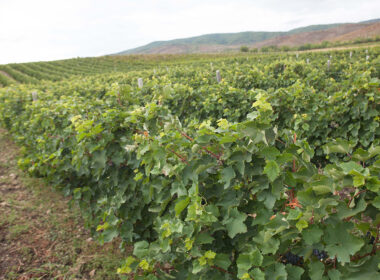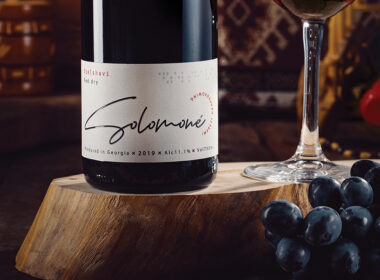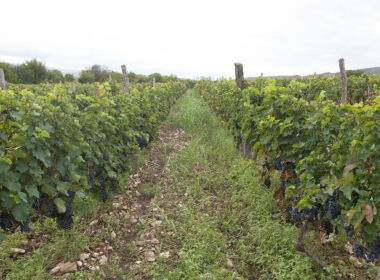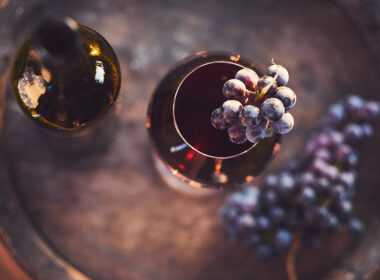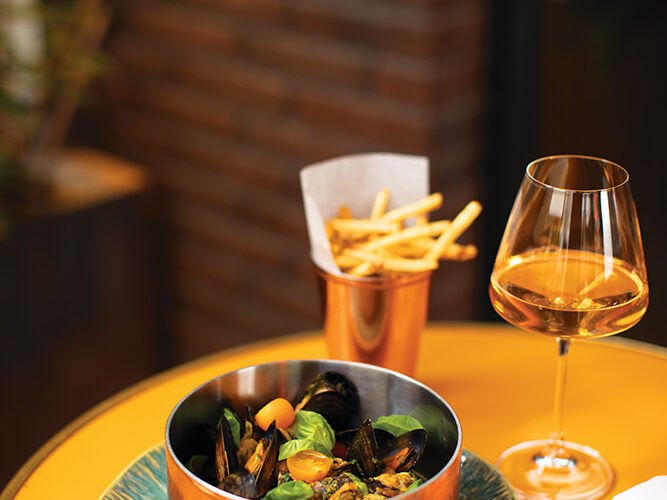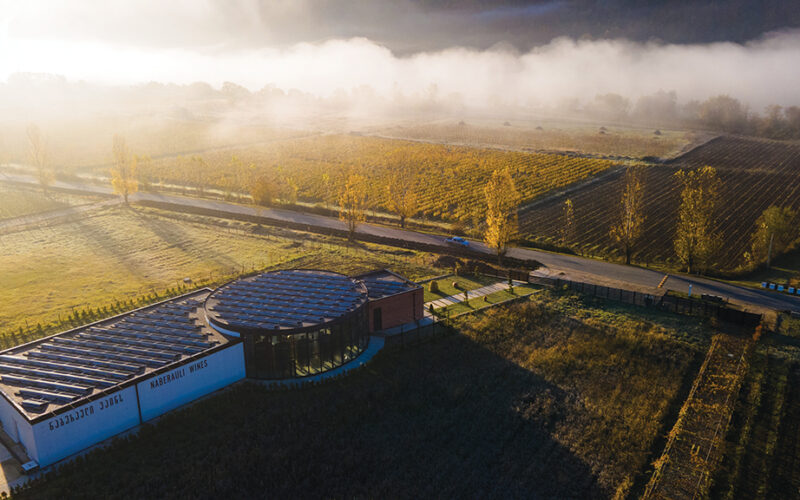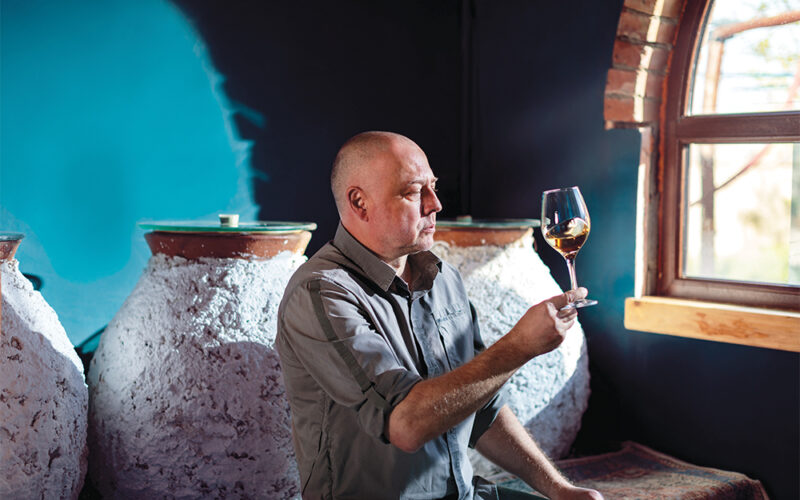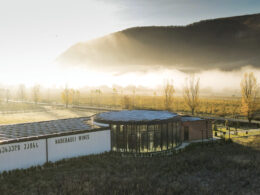| Homeland of Wine |
Food and Wine | Tazo Tamazashvili | Best Sommelier of Georgia 2018
Guria, a vibrant and dynamic region in Georgia, exudes its spirited nature through its lively dialect and manner of speech. Its people are known for their cheerfulness, vitality, and exceptional hospitality. A great sense of humor is a defining characteristic of this region. Local winemaking in Guria stands out as a small pearl of Georgia, accentuated by its geographical position, bordering multiple regions of Western Georgia and the Black Sea, rendering it a subtropical zone.

The Guria region encompasses the southern periphery of the Colchis Lowland and the northwestern extensions of the Meskheti ridge. It shares borders with the Samegrelo-Zemo Svaneti region to the north, the Imereti region to the east, Ajara to the south, and the Black Sea to the west.
Guria has long been renowned for its distinctive winemaking traditions that feature unique grape varieties, the majority of which are exclusive to the region and cannot be found elsewhere in the country. Here, there are descriptions of 59 autochthonous grape varieties, with Chkhaveri being the most prominent. Chkhaveri stands out for its versatile color range, transitioning between hues of red and pink grape varieties. Depending on its ripeness, this grape can yield red, rose, amber, or white wines. Chkhaveri’s most exceptional trait lies in its capability to produce wines of various colors using only one grape variety. It’s rare to find another small region that provides such diversity, not just enhancing its own nation but also influencing the global wine scene. There’s no other region that comes to mind that can produce numerous wine types from just a single variety.
The significance of Guria as an ancient wine-producing region is further evidenced by the renowned qvevri craftsmanship in villages like Atsana and Aketi (Lanchkhuti municipality). Qvevris crafted in these villages have long been esteemed as among the finest in Georgia.
The essence of Gurian tradition, culture, and spirit is distinctly reflected in the local grape varieties and wines.
Today, viticulture and winemaking are more developed in other parts of Georgia than in Guria. This is largely due to the widespread destruction of vineyards during the Soviet era, which were often replaced by tea and tobacco plantations.
Nevertheless, this region has all the essential elements for its advancement – an array of grape varieties, the diligent efforts of its inhabitants, soils, and a climate.
Guria currently lacks even a single PDO. Dedicated terroirs, which are crucial, are also absent. If we were to draw inspiration from German viticulture, where slopes near rivers are actively utilized, a similar approach could be adopted in Guria.
In this small region, there is a variety of rivers and valleys, such as Supsa, Achistskali, Bakhvistskali, Bzhuzhi, Gubazeuli, Khevistskali, and more. If we divide these into terroirs, imagine, we’ll have the vineyards of Supsa or the slopes of Bakhvistskali. Conducting such terroir research would empower locals to tailor grape varieties to specific terroirs. Consequently, the vineyards will be less susceptible to issues like excess moisture, ash, and powdery mildew, which currently pose significant challenges for Gurian winegrowers. To propel the region forward, addressing such issues should be the initial focus.
Picture the fascination, for any foreign sommelier, upon learning that terroir zoning in a previously uncharted region has taken place in Georgia. For me, such news would be captivating, prompting an immediate search for wines from the area to sample. This approach also greatly benefits winemakers, propelling them forward and providing opportunities for further education.
My desire for Gurian winemakers is to pursue further education in viticulture and winemaking, and then apply that knowledge to their wines.
If one region progresses in terroir zoning, others will likely follow suit. In this regard, I see the greatest potential in Guria. Much of the soil here remains untapped. While various crops, including cereals, are currently cultivated, replacing them with vineyards could eventually produce high-quality wines from the grapes grown within them.
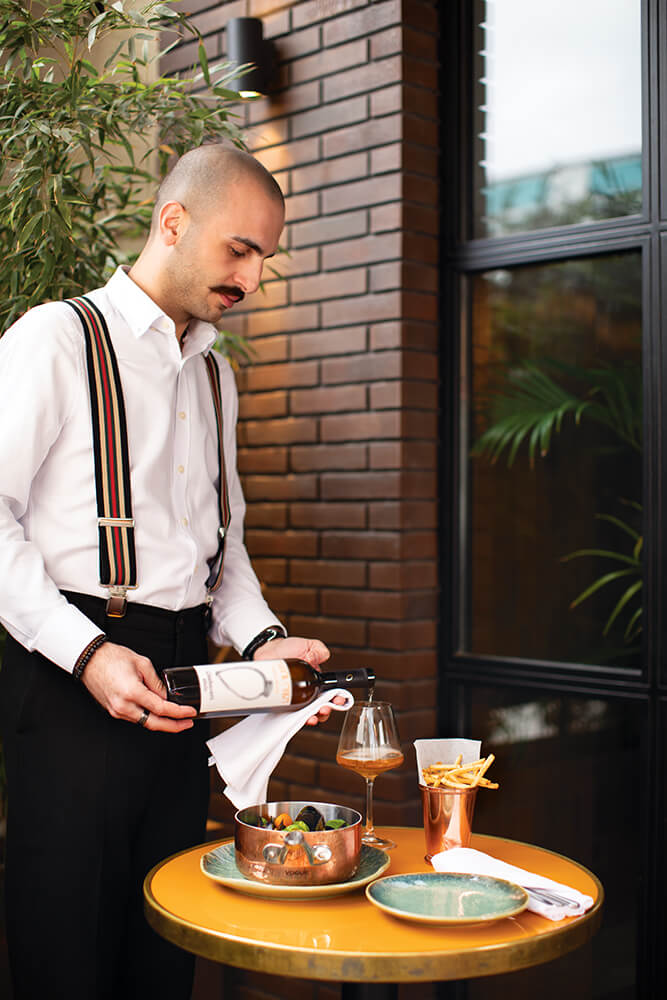
Gurian Cooking
Even the cuisine of Guria stands out for its distinctiveness and diversity, encompassing wild forest cuisine, vegetable-based dishes, river fish, and Black Sea delicacies. Together with Gurian wines, these culinary offerings warrant more exposure. For me, Gurian cuisine always brings to mind spicy dishes, with their hot, vibrant and healthy tones. The dishes you’ll try in this region are bound to have acidity, saltiness, and spice. Indeed, the diversity of Guria is directly reflected in their dishes and wines.
Pairing Gurian Wines With Dishes
We pair Gurian wines with dishes crafted by brand-chef Tekuna Gachechiladze at Bazzar Hotel restaurant.
Chkhaveri, paired with smoked salmon, served with citrus, green ajika, and lettuce leaves.
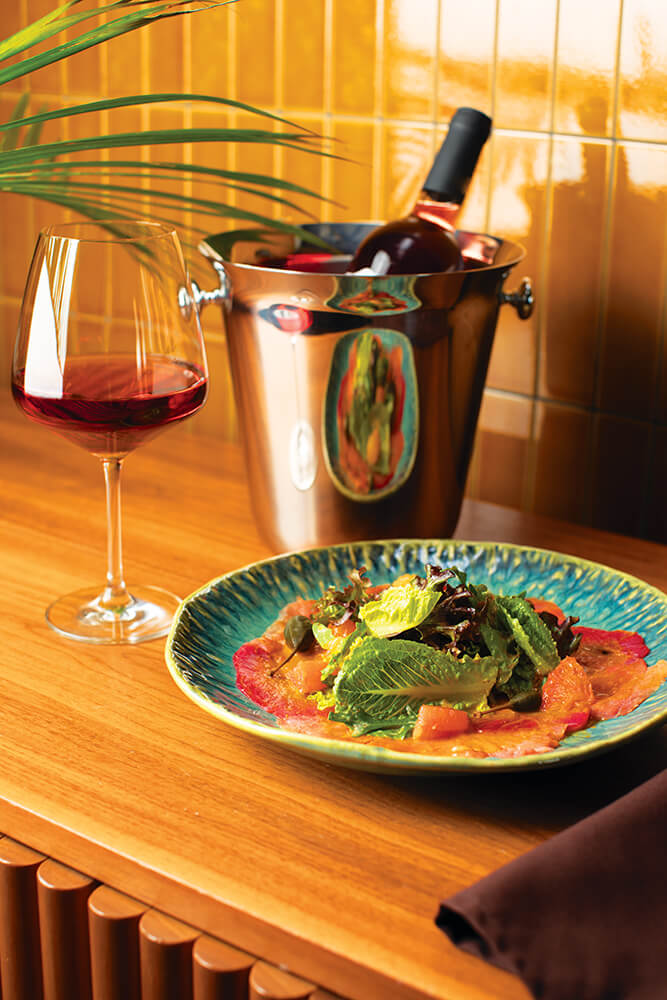
In the salad, we feature both smoked and beetroot-marinated salmon, known for its oiliness and delicate flavour. Such a nuanced taste calls for pairing with an exceptional wine.
Therefore, I’ve chosen the 2021 vintage Ancestors’ Wine from Dato’s Wine winery. Crafted by Dato and Tato Kobidze, this limited edition wine is made from 150-year-old Chkhaveri grapes cultivated by their ancestors in the village of Erketi. Fermented in contact with Chacha (pomace) for 3 days, it boasts a vibrant pink hue, balanced taste, and aroma. Aged in the bottle for 2 years, this wine has retained its impeccable flavour and balance.
The smoky flavours of the salmon, citrusy aromas, beetroot marination, and green ajika (Georgian hot dip) sauce, infuse the salad with a zest that beautifully complements the berry and citrus notes of Chkhaveri wine.
Chkhaveri is renowned for its high acidity, particularly when young, which mellows with aging. The well-balanced acidity of this wine pairs harmoniously with the mildly salty salmon in the salad, creating an ideal combination. Furthermore, Chkhaveri’s smoky undertones acquired during bottle aging ideally complement the smoky undertones of the fish.
Mushroom with Risotto and Skhilatubani Aged in Qvevri
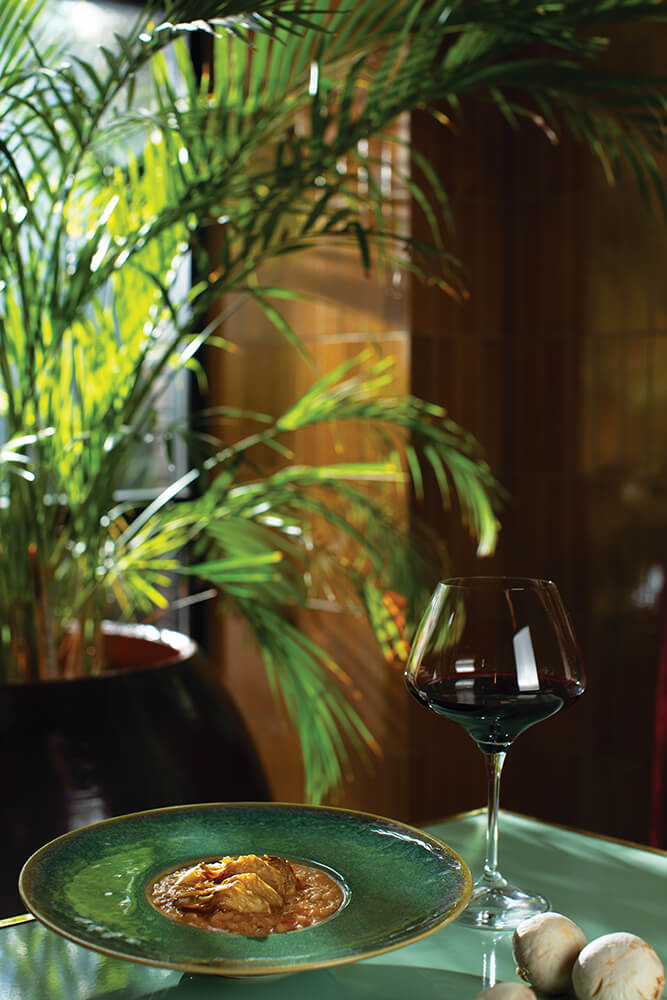
My preferred culinary destination is wild forest foods. In Georgia, including Guria, a plethora of mushroom varieties can be found, often used by locals in their cooking. The Gurian people possess a profound knowledge of forest foods. Rebellions against Georgia’s adversaries frequently unfolded in these parts, with rebels often seeking refuge in the wooded areas. For this reason, Gurians hold a deep-seated belief in nature’s ability to save them, which is why I I find it fitting to pair a mushroom dish with Gurian wine. We paired the mushroom risotto with a wine aged in qvevri, crafted from one of Guria’s oldest, rarest, and most esteemed varieties – Skhilatubani. When properly matured in qvevri, it develops pronounced notes of wet earth, rain, leaves, dried berries, and aged wood.
The earthy and rainy notes of mushrooms harmonize with those found in the wine, resulting in a good pairing. Burgundy, a personal favorite region of mine, provides a notable example where mushroom dishes are frequently matched with well-aged Pinot Noirs. These wines gradually develop hints of truffles and forest mushrooms, elevating the flavour profile.
Skhilatubani, with its subtle acidity, complements both the umami tones of the mushrooms and the saltiness of the risotto broth, resulting in a very comforting flavour. I’d love to experience this wine amidst the Gurian wilderness, paired with ember-roasted mushrooms.
Mussels with Basil and Cherry Tomato and Tetri Kamuri

The Black Sea and Guria’s coastal areas boast a wealth of fish and seafood that should be incorporated into the region’s culinary heritage.
The Black Sea mussels stand out for their distinct saltiness and mineral-rich flavour profile. Since there are no mussle farms in Georgia, the wild mussels harvested from the Black Sea offer unique taste attributes. It’s my wish that Gurian cuisine would embrace a greater variety of seafood, especially considering that the white grape varieties in this region, known for their characteristic mineral and citrus flavours, are ideally suited to such cuisine.
I’d like to complement mussels cooked in a white wine sauce, alongside basil and cherry tomatoes, with Tetri Kamuri. This ancient and scarce Gurian grape variety possesses unique characteristics that make it perfect for producing exceptional wines, whether through the traditional Churi (qvevri in Western Georgia) method or the classical approach.
The Tetri Kamuri paired with the mussels dish is crafted in contact with 15% Chacha solely during the fermentation process, after which the juice and skins are separated.
The wine displays a straw-coloured hue and features distinct citrus, orange, lemon zest, floral, and mineral notes. Its subtle saline undertones are attributed to the limestone and stony soils of Bukistsikhe, where it is cultivated. Tetri Kamuri adeptly absorbs needed essential minerals from the soil and imparts them to the wine.
Mussels, with their wonderful sea essence, enhanced by basil and cherry tomatoes, resonate with the spirited character of Guria. They harmonize beautifully with Tetri Kamuri, whilst the minerality, acidity, and saltiness converge to achieve exquisite balance. The refined essence of the mussels and the lively citrus undertones of the wine linger on the palate, leaving a lasting impression.
Mille-feuille and Naturally Semi-Sweet Tsolikouri from Erketi
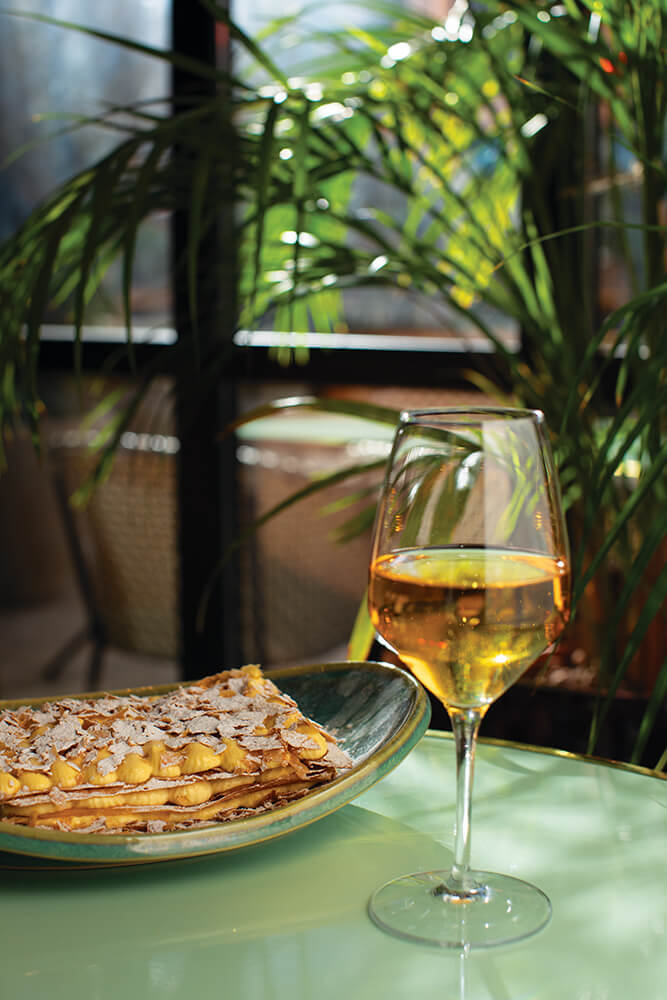
For dessert, we’ve selected a renowned international delicacy – Mille-feuille, paired with a naturally semi-sweet Tsolikouri from Erketi. This innovative pairing is a subtle suggestion to our colleagues to explore the harmony of such wines with similarly light and velvety international desserts.
In Georgia, we have a distinct PDO zone known as Tvishi, which has gained recognition in international markets. Here, naturally semi-sweet wines are produced from Tsolikouri grapes. The semi-sweet Tsolikouri that we pair with dessert originates from the village of Erketi in Guria, where Tsolikouri is the most widely cultivated white grape variety.
I believe it would be intriguing to apply the Tvishi winemaking technique to Tsolikouri and conduct a terroir comparison between these two wines.
The refined, naturally semi-sweet, Tsolikouri showcases tones of orange blossom, white stone fruits, tropical fruits like papaya and mango, and melon, echoing similarities found in Tvishi. These elements contribute to the wine’s citrusy undertones in both aroma and taste, accompanied by a delicate balance of sweetness and acidity. Such a wine pairs exceptionally well with light desserts, as the harmonious interplay between acidity and sweetness enhances the overall experience.

In the future, I would hope for one of Guria’s specific terroirs or appellations of origin to have the chance to craft naturally sweet wines from Tsolikouri, a white grape variety distinctive to this area, similar to renowned wines such as Tokaji, Sauternes, and Barsac.
გურია – მხარე უნიკალური ჯიშებით, დიდი შესაძლებლობებით, მრავალფეროვნებით, რაც ასახულია აქაურ კერძებსა და ღვინოებში
თაზო თამაზაშვილი | საქართველოს საუკეთესო სომელიე, 2018
ურია საქართველოს ცინცხალი და სხარტი მხარეა. აქაურებს სისხარტეს საუბრის მანერაშიც შეატყობთ და კილოშიც. მხიარულები, ლაღები, სიცოცხლით სავსეები და საოცრად სტუმართმოყვარეები არიან. საუცხოო იუმორი კი ამ კუთხის ერთ-ერთი მთავარი მახასიათებელია. აქაური მეღვინეობა საქართველოს პატარა მარგალიტია, მხარე კი გამორჩეული თავისი გეოგრაფიული მდებარეობით – დასავლეთ საქართველოს რამდენიმე რეგიონი და შავი ზღვა ესაზღვრება, რაც გურიას სუბტროპიკულ ზონად აქცევს.
გურია ყოველთვის იყო მეღვინეობის გამორჩეული მხარე ყურძნის ისეთი ჯიშებით, რომლთაგან უმეტესობა ჩვენი ქვეყნის სხვა რეგიონებში გაშენებული არ არის. აქ 59 ავტოქთონური ჯიშია აღწერილი, მათ შორის ფლაგმანი კი ჩხავერია, რომელსაც ფერის მხრივ წითელსა და ვარდისფერყურძნიან ჯიშებს შორის გარდამავალი გამა გააჩნია და სიმწიფიდან გამომდინარე, მისგან შეიძლება დამზადდეს როგორც წითელი, ვარდისფერი და ქარვისფერი, ისე თეთრი ღვინოები. ამაშია ჩხავერის უნიკალურობა – ერთი ჯიშისგან შეგიძლიათ დააყენოთ ყველა ფერის ღვინო. ვერ ვიხსენებ სხვა ასეთივე პატარა რეგიონს, რომელსაც შეუძლია მსგავსი მრავალფეროვნება მისცეს არა მხოლოდ თავის ქვეყანას, არამედ მსოფლიოს. არც ისეთი რეგიონი მახსენდება, რომელიც თუნდაც ერთი ჯიშისგან ამდენი სახეობის ღვინოს აწარმოებს.
გურია რომ მეღვინეობის უძველესი რეგიონია, ამას ისიც ადასტურებს, რომ სოფლები აცანა და აკეთი (ლანჩხუთის მუნიციპალიტეტი) ყოველთვის იყო განთქმული მექვევრეობით. ამ ორ სოფელში შექმნილი ქვევრები ყოველთვის საუკეთესოდ ითვლებოდა საქართველოში.
გურული ტრადიცია, კულტურა და ამ კუთხის სული ყოველთვის იგრძნობა აქაურ ყურძნის ჯიშებშიც და ღვინოებშიც.
დღეს, საქართველოს სხვა კუთხეებში მევენახეობა-მეღვინეობა ბევრად განვითარებულია, ვიდრე გურიაში. ამისმიზეზადაც ჯერ კიდევ საბჭოთა პერიოდში ვენახების მასობრივი განადგურება და მათ ადგილას ჩაისა და თამბაქოს პლანტაციების გაშენებაც შეგვიძლია დავასახელოთ. არადა, განვითარებისთვის ამ მხარეს ყველაფერი უწყობს ხელს: ჯიშთა მრავალფეროვნება, ხალხის შრომისმოყვარეობა, ნიადაგები, კლიმატი.
გურიას ჯერჯერობით არ გააჩნია არცერთი ადგილწარმოშობის დასახელება. არ გვაქვს გამოყოფილი ტერუარები, რაც ასე აუცილებელია. გერმანული მევენახეობის მაგალითი რომ ავიღოთ, სადაც ისინი აქტიურად იყენებენ მდინარეებთან ახლოს მდებარე ფერდობებს, მსგავსი ექსპოზიცია შეგვიძლია გურიასაც მოვარგოთ. ამ პატარა მხარეში გვაქვს მდინარეები და ხეობები, მათ შორის, სუფსა, აჭისწყალი, ბახვისწყალი, ბჟუჟი, გუბაზეული, ხევისწყალი და სხვა. ეს ყველაფერი ტერუარებად რომ ჩავშალოთ, წარმოიდგინეთ, რომ გვექნება – სუფსის ვენახები, ბახვისწყლის ფერდობები და ასე შემდეგ. ასეთი ტერუარული კვლევა გურულებს საშუალებას მისცემს, ჯიშები სწორად მოარგონ კონკრეტულ ტერუარებს. შედეგად, ვენახს ნაკლებად შეაწუხებს ზედმეტი ტენიანობა, ნაცარი, ჭრაქი, რაც დღეს გურული მევენახეებისთვის დიდ პრობლემას წარმოადგენს. თუ გვსურს, რეგიონი წინ წავწიოთ, პირველ რიგში სწორედ ასეთი საკითხების გადაჭრით უნდა დავიწყოთ.
წარმოიდგინეთ, ნებისმიერი უცხოელი სომელიესთვის რამდენად საინტერესო შეიძლება იყოს ინფორმაცია, რომ საქართველოში ტერუარული ჩაშლა მოხდა იმ რეგიონის, რომელიც აქამდე არ ჩანდა. ჩემთვისაც კი ბუმი იქნებოდა ასეთი ამბავი, მაშინვე დავიწყებდი ამ რეგიონის ღვინოების მოძიებას. ასეთი მიდგომა მეღვინეებსაც ეხმარება, წინ სწევს, საშუალებას აძლევს, მიიღონ მეტი განათლება.
რასაც ვუსურვებ გურულ მეღვინეებს, არის ის, რომ მეტი განათლება მიიღონ/ჩადონ მევენახეობა-მეღვინეობის დარგში, შემდეგ კიეს განათლება ჩადონ თავიანთ ღვინოებში.
თუ ტერუარებად ჩაშლის მხრივ ერთი რეგიონი მაინც წაიწევს წინ, მას აუცილებლად მიჰყვებიან სხვებიც. ამ მხრივ, ყველაზე დიდ პერსპექტივას სწორედ გურიაში ვხედავ. აქაური ნიადაგების დიდი ნაწილი ასათვისებელია. ამ ნიადაგებზე დღეს, სხვადასხვა კულტურები მოჰყავთ (მათ შორის, მარცვლეული), არადა, მათ ნაცვლად რომ გაშენდეს ვენახები, გარკვეული დროის შემდეგ, ამ ვენახებში მოყვანილი ყურძნისგან თავისუფლად შეიძლება მაღალი კლასიფიკაციის ღვინოები დამზადდეს.
გურული კულინარია
გურიას კულინარიაც კი გამორჩეული და მრავალფეროვანი აქვს – ტყის ველური სამზარეულო, მცენარეული კერძები, მდინარის თევზეული თუ შავი ზღვის პროდუქტები. ამ ყველაფერს, გურულ ღვინოებთან ერთად, ცოტა მეტად უნდა წინ წამოწევა.
გურული კულინარია ჩემთვის ყოველთვის ასოცირდება სანელებლებიან კერძებთან, სიცხარესთან, ცინცხალ და ჯანსაღ ტონებთან. კერძებს, რომლებსაც ამ რეგიონში გასინჯავთ, აუცილებლად ექნება მჟავიანობაც, მარილიანობაც და სიცხარეც. დიახ, გურული მრავლფეროვნება პირდაპირ არის ასახული მათ კერძებსა და ღვინოებში.
გურული ღვინოების შეხამება კერძებთან
გურულ ღვინოებს Bazzar Hotel-ის რესტორნის კერძებთან ვაწყვილებთ, რომლებიც ბრენდ-შეფ თეკუნა გაჩეჩილაძის მიერ არის შექმნილი.
ჩხავერი და შებოლილი ორაგული ციტრუსით, მწვანე აჯიკითა და სალათის ფოთლებით
სალათში ორაგული როგორც შებოლილი, ისე ჭარხალში დამარინადებული სახით არის წარმოდგენილი. ეს თევზი გამოირჩევა ცხიმიანობითა და მსუბუქი, დელიკატური გემოთი, რომელიც დახვეწილ ღვინოსთან დაწყვილებას მოითხოვს. ამიტომაც შევარჩიე მეღვინეობა Dato’s Wine-ს წინაპრების ღვინო, 2021. ამ ლიმიტირებული სერიის ღვინოს დათო და ტატო კობიძეები თავიანთი წინაპრების მიერ სოფელ ერკეთში დარგული 150-წლოვანი ჩხავერის ჯიშის ყურძნისგან ამზადებენ. ღვინო ჭაჭაზე 3 დღეა დაყოვნებული, არის მკვეთრი ვარდისფერი შეფერილობის, დაბალანსებული გემოთი და არომატით. ორი წლის განმავლობაში ბოთლში დაძველებულ ამ ღვინოს იდეალურად აქვს შენარჩუნებული გემო და ბალანსი.
ორაგულის შებოლვის გემოები, ციტრუსის არომატები, ჭარხალში დამარინადება, მწვანე აჯიკის სოუსი – ეს ყველაფერი სალათში გვაძლევს იმ სიცინცხალეს, რომელიც ძალიან უხდება ჩხავერის კენკროვან და ციტრუსოვან გემოებსა და არომატებს.
ჩხავერს ყოველთვის ახასიათებს მაღალი მჟავიანობა, განსაკუთრებით როცა ღვინო ახალგაზრდაა. დაძველებისას კი აკლდება. ამ ღვინოში მჟავიანობა კარგად არის დაბალანსებული, სალათში წარმოდგენილი ორაგულიც ნელმარილიანია, ამიტომაც ეს კომბინაცია იდეალურ შეხამებას გვაძლევს. ჩხავერის ბოთლში დაძველებისას შეძენილი კვამლის ტონები შესანიშნავად წყვილდება თევზის შებოლვის ტონებთან.
სოკო რიზოტოთი და ჭურში დაყენებული სხილათუბანი
ჩემი საყვარელი მიმართულებაა ტყის ველური სამზარეულო. საქართველოში, მათ შორის, გურიაში მრავლად მოგვეპოვება სოკოს ნაირსახეობები, რომლებსაც აქაურები კერძების მოსამზადებლად ხშირად იყენებენ. გურულებმა ტყის სამზარეულო ყოველთვის კარგად იცოდნენ. ამ მხარეში საქართველოს მტრის წინააღმდეგ აჯანყებები ხშირად ხდებოდა. მეომართა რაზმებს ტყეში უწევდათ გახიზვნა. ამიტომაა, რომ გურულებს სისხლსა და ხორცში აქვთ გამჯდარი შეგრძნება, რომ ბუნება მათ ყოველთვის გადაარჩენს. აქედან გამომდინარე, ჩავთვალე საჭიროდ, სოკოთი მომზადებული კერძი შემეხამებინა გურულ ღვინოსთან.
სოკოს რიზოტო ერთ-ერთი უძველესი, იშვიათი და დაფასებული გურული ჯიშის – სხილათუბნისგან ჭურში დაყენებულ ღვინოსთან დავაწყვილეთ. სხილათუბანი, როდესაც ჭურში კარგად მომწიფდება, აქვს გამოკვეთილი სველი მიწის, ფოთლოვანი, გამომშრალი კენკრისა და გამომშრალი ხის მერქნის ტონები. წვიმის და მიწის ტონები მეორდება სოკოს შემთხვევაშიც და სწორედ არომატთა ეს ერთობლიობა ქმნის კარგ წყვილს. შემიძლია, მაგალითად მოვიყვანო ისევ ჩემი საყვარელი რეგიონი – ბურგუნდია, სადაც სოკოსგან მომზადებულ კერძებს უხამებენ კარგად დაძველებულ პინო ნუარებს, რომლებშიც ტრიუფელისა და ტყის სოკოს ტონებია წამოსული.
სხილათუბანი, თავისი დახვეწილი მჟავიანობით, იდეალურად ეხამება როგორც სოკოს უმამის ტონებს, ისე რიზოტოს ბულიონის მარილიანობას და ქმნის ძალიან კომფორტულ გემოს. ვისურვებდი, ეს ღვინო, გურიის ბუნებაში, ნაკვერჩხალზე შემწვარ სოკოსთანაც გაგვესინჯა აუცილებლად.
მიდიები ბაზილიკითა და ჩერი პომიდვრით და თეთრი კამური
შავი ზღვა და გურიის სანაპიროები მდიდარია თევზეულითა და ზღვის პროდუქტებით, რასაც აუცილებლად უნდა გადმოტანა ადგილობრივ სამზარეულო კულტურაში.
შავი ზღვის მიდიები გამოირჩევა მარილიანობით და მინერალური გემოთი. საქართველოში, საფერმე მეურნეობები არ გვაქვს, ამიტომ ველური მიდიები, რომლებსაც შავი ზღვა გვჩუქნის, განსაკუთრებული გემური მახასიათებლებით გამოირჩევა. ვისურვებდი, გურული სამზარეულო მეტად იყოს დატვირთული ზღვის პროდუქტებით, რადგან აქაური თეთრყურძნიანი ჯიშები, მათთვის სახასიათო მინერალური და ციტრუსოვანი გამოხატულებით, პირდაპირ არის მორგებული ასეთ სამზარეულოს.
მიდიები თეთრი ღვინის სოუსში, ბაზილიკითა და ჩერი პომიდვრით მინდა შევუხამო თეთრ კამურს. ეს ერთ-ერთი უძველესი და იშვიათი გურული ჯიშია, რომელსაც უნიკალური მონაცემები გააჩნია იმისთვის, რომ მისგან დამზადდეს საუცხოო ღვინოები როგორც ჭურის, ისე კლასიკური მეთოდით.
თეთრი კამური, რომელსაც მიდიებისგან მომზადებულ კერძთან ვაწვილებთ, დამზადებულია 15% ჭაჭაზე, რომელიც მხოლოდ ფერმენტაციის პროცესში ჰქონდა.შემდეგ მოხდა წვენისა და დურდოს განცალკევება. ღვინოს აქვს ჩალისფერი შეფერილობა, გამოირჩევა ციტრუსოვანი, ფორთოხლის, ლიმნის ცედრის, ყვავილოვანი და მინერალური ტონებით. გემოში მარილიანობაც კი ახასიათებს, რადგან ბუკისციხეში კირქვა და ქვიან ნიადაგებზეა გაშენებული. თეთრი კამური ნიადაგიდან კარგად იღებს ზუსტად იმ მინერალებს, რომლებიც შემდეგ ღვინოში უნდა გადმოგვცეს.
მიდიები ზღვის საუცხოო გემოებით, რომლებიც გამდიდრებული და გაცინცხალებულია (როგორც ეს გურულ ხასიათს უხდება) ბაზილიკითა და ჩერი პომიდვრით, კარგი წყვილია თეთრ კამურთან. ერთმანეთს ემთხვევა მინერალურობა, მჟავიანობა და მარილიანობა, რაც იდეალურ ბალანსს ქმნის. მიდიების დახვეწილი და დელიკატური გემო და ღვინის ცოცხალი ცისტრუსოვანი ტონები საკმაოდ ხანგრძლივად მიგყვებათ.
მილფეი და ბუნებრივად ნახევრადტკბილი ცოლიკოური ერკეთიდან
დესერტად შევარჩიეთ საერთაშორისო სამზარეულოს ერთ-ერთი საუკეთესო ნიმუში – მილფეი, რომელთანაც ვაწყვილებთ ბუნებრივად ნახევრადტკბილ ცოლიკოურს ერკეთიდან. ეს ექსპერიმენტული შეხამება არის გზავნილი, რომელიც მსურს, ჩვენს კოლეგებს მივაწოდო, რათა მათ აუცილებლად მიირთვან ასეთი ღვინოები მსგავსი ტიპის მსუბუქ და ხავერდოვან საერთაშორისო დესერტებთან.
საქართველოში გვაქვს გამორჩეული ადგილწარმოშობის დასახელების ზონა – ტვიში, რომელიც ცნობილია საერთაშორისო ბაზრებისთვისაც. აქ ცოლიკოურის ჯიშის ყურძნისაგან ბუნებრივად ნახევრადტკბილი ღვინოები მზადდება. ეს ნახევრადტკბილი ცოლიკოური კი, რომელსაც დესერტთან ვაწყვილებთ, გურიის სოფელ ერკეთიდან გახლავთ.
ცოლიკოური გურიაში ყველაზე განშენიანებადი თეთრყურძნიანი ჯიშია. ვფიქრობ, ძალიან საინტერესო იქნება ტვიშის ტექნოლოგიის გადმოტანა და მეტად მოსინჯვა ცოლიკოურზე, შემდეგ კი ამ ორი ღვინის ტერუარული შედარების გაკეთება.
ბუნებრივად ნახევრადტკბილი ცოლიკოურის დახვეწილი, ფორთოხლის ყვავილის, თეთრი კურკოვანი ხილის, ტროპიკული ხილის, მათ შორის, პაპაიას, მანგოს, ასევე ნესვის ტონები, სიტკბოსთან და დელიკატურ მჟავიანობასთან ერთად, ღვინოში ციტრუსოვან ტონსაც გვაძლევს როგორც გემოში, ისე არომატში. ასეთი ღვინო იდეალურია მსუბუქ დესერტებთან, რადგან მჟავიანობა და სიტკბო ერთმანეთთან იდეალურად მოქმედებს.
სამომავლოდ, ვისურვებდი, გურიაში ერთ-ერთ ტერუარს, ან კონკრეტულ ადგილწარმოშობას ჰქონდეს შესაძლებლობა, ცოლიკოურისგან, რომელიც ამ რეგიონისთვისაც დამახასიათებელი თეთრყურძნიანი ჯიშია, დამზადდეს ბუნებრივად ტკბილი ღვინოები, როგორიც თუნდაც ტოკაი, სოტერნი ან ბარსაკია.

